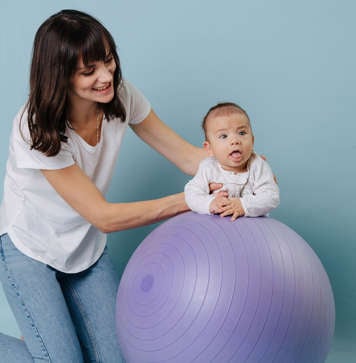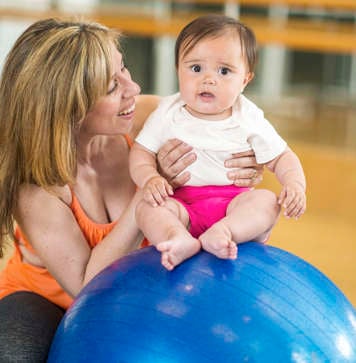Learning to hold their head and trunk up is one of the earliest movement skills your child will develop. Strong neck, stomach and back muscles are important for the development of later movement skills such as sitting, standing and hand/finger skills. One of the more important positions for developing head and trunk control is tummy time. It is important for your child to practice tummy time activities when they are awake and supervised. Try doing these activities throughout each day when your child is happy and ready to play.

Carrying child on your chest
Hold your child’s hips and back. This is a good position to introduce tummy time. As your child gets stronger, they will lift their head up to look around and you can then try carrying them over your shoulder.

Lying on your chest
Lie down and place your child on their tummy on your chest. Ensure their arms are forward so they can push up and lift their head to look up at you.

Side-lying
- Side-lying helps develop tummy and back muscles and is the position your child will move through as they learn to roll. It also helps your child learn to bring their hands together. Place your child on their side. At first, you may place a rolled blanket behind their back and even one in front to help them stay on their side. Bend their top leg over the top of their bottom leg. Ensure both arms are forward so they can bring them together.
- Place colourful toys or a toy mirror to encourage your child to bring their head forward to look at them.
- Remember to practice lying on both left and right sides. This will also help prevent their head from getting too flat on one side.

Learning to hold head in line with body
- Place your child on their back with their head in line with their body. If they are unable to hold this position on their own, place your hand on your child’s chest to provide some extra stability. Encourage them to look at you or an interesting toy. Help your child bring their hand to their mouth to explore. You can also try this activity holding your child supported on your lap.
- Once your child can keep their head in the middle, then practice having them move their head from side to side. Slowly move a toy or your face to one side and then back to the middle while encouraging your child to follow.

Carrying child facing outwards
Support your child’s trunk and hips as needed. Encourage them to hold their head up to look at their surroundings. Alternate which arm you carry your child on so they develop strong neck and back muscles on both the left and right sides of their body.

Sitting up in infant seat
Encourage your child to spend short periods of time upright in a supportive infant seat (NOT a car seat). Use rolled blankets to keep their head and body in the middle so they do not lean to one side. This is a good position to interact with your baby by talking, singing or reading. You can also help your baby learn to follow interesting toys with their eyes.

Supported sitting
- Place one hand on your child’s chest and your other hand on their back. Give gentle inward & downward pressure with your hands. This will help your child more easily lift their head and straighten their back.
- This will be difficult for them at first, and their head will “bob” up and down until they get stronger. Keep your hands close to their neck to provide support as needed.
- As your child gets stronger, you can try gently tipping them to each side to help them learn to keep head in line with their body. You can also move your hands further down their trunk as they get stronger.
Lifting child by rolling up to sitting position
- Put your child on their back on the floor/mat or on your lap.
- Hold your child by their shoulders or alongside their trunk.
- Slowly turn your child to the side while lifting them up to a sitting position. Your child will try to help by bringing their head forward.
- Once they are sitting, you can do the reverse. Slowly turn them to their side and slowly lower them onto their back.
- Remember to practice both left and right sides.

Elevated tummy time
Some children enjoy tummy time more if they are elevated compared to being flat on their tummy. Try introducing tummy time over a breastfeeding pillow, over your thigh or even supported over a couch cushion.

Tummy time carry
Place your child over your arms on their tummy. Rock them gently back and forth. Doing this activity in front of a mirror may encourage your child to lift their head.

Tummy time with roll under arms
Place a rolled blanket or cushion under your child’s chest and arms to help make it easier for them to lift their head. Ensure their arms are forward with their elbows under their shoulders. Encourage them to take their weight through their arms and hands and lift their head up. Provide some pressure to their bottom to provide extra stability and to help bring their weight backward. This makes it easier for your child to lift their head up.

Lying across your legs
Place your child on their tummy over your thighs. Support their back and hips. Encourage them to lift their head to look up at a toy. Your child may enjoy gently bouncing or having you pat their bottom in this position.

Flat tummy time
As your child gets stronger, place them on their tummy on a blanket on the floor/mat. If you lay down in front of them it can encourage them to lift their head and push up on their arms to look at you. You can try shaking a colourful or musical toy in front of them to encourage them to lift their head up to look at it.

Tummy time on ball
Place your child on their tummy on an exercise ball. Support your child and give some downward pressure on their bottom to help them lift their head more easily. Slowly rock your child on the ball forward, backward and side to side. You can also try gently bouncing the ball up and down. Singing songs on the ball or going in front of a mirror can be fun activities for your child.

Sitting on ball
Support your child in a sitting position on a large exercise ball. Gently bounce your child up and down and slowly rock them from side to side. Encourage them to lift their head and straighten their back to look around.
Additional activities recommended by your child’s therapist